Situation Analysis of Harry's Ice Cream Industry - MKT600 Marketing
VerifiedAdded on 2023/04/08
|18
|3060
|488
Report
AI Summary
This situation analysis report examines the macro and micro environment of Harry's Ice Cream Industry in Australia, a family-owned SME established in 1994. The report delves into the industry's growth from a small retail operation to a manufacturing unit supplying major retailers like Coles and Woolworths. It analyzes the macro environment, including industry analysis, value chain, and PESTEL factors, highlighting technology as a key opportunity and legal considerations as a potential threat. The microenvironment analysis focuses on consumer behavior using the STP model, company analysis, and competitor analysis. The report concludes by summarizing the key findings and discussing strategies for improving the company's market position. Desklib offers a variety of study resources, including past papers and solved assignments.
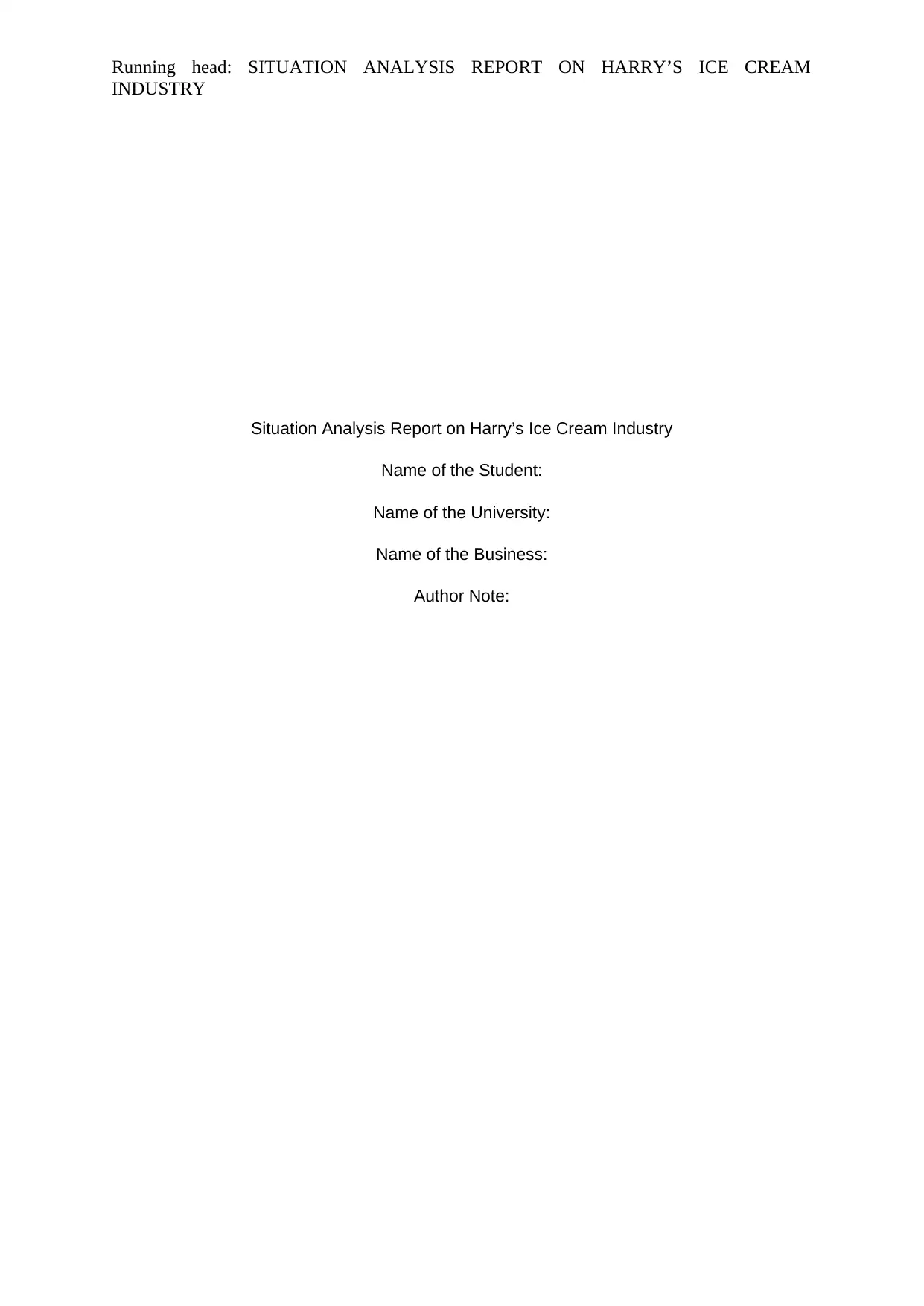
Running head: SITUATION ANALYSIS REPORT ON HARRY’S ICE CREAM
INDUSTRY
Situation Analysis Report on Harry’s Ice Cream Industry
Name of the Student:
Name of the University:
Name of the Business:
Author Note:
INDUSTRY
Situation Analysis Report on Harry’s Ice Cream Industry
Name of the Student:
Name of the University:
Name of the Business:
Author Note:
Paraphrase This Document
Need a fresh take? Get an instant paraphrase of this document with our AI Paraphraser
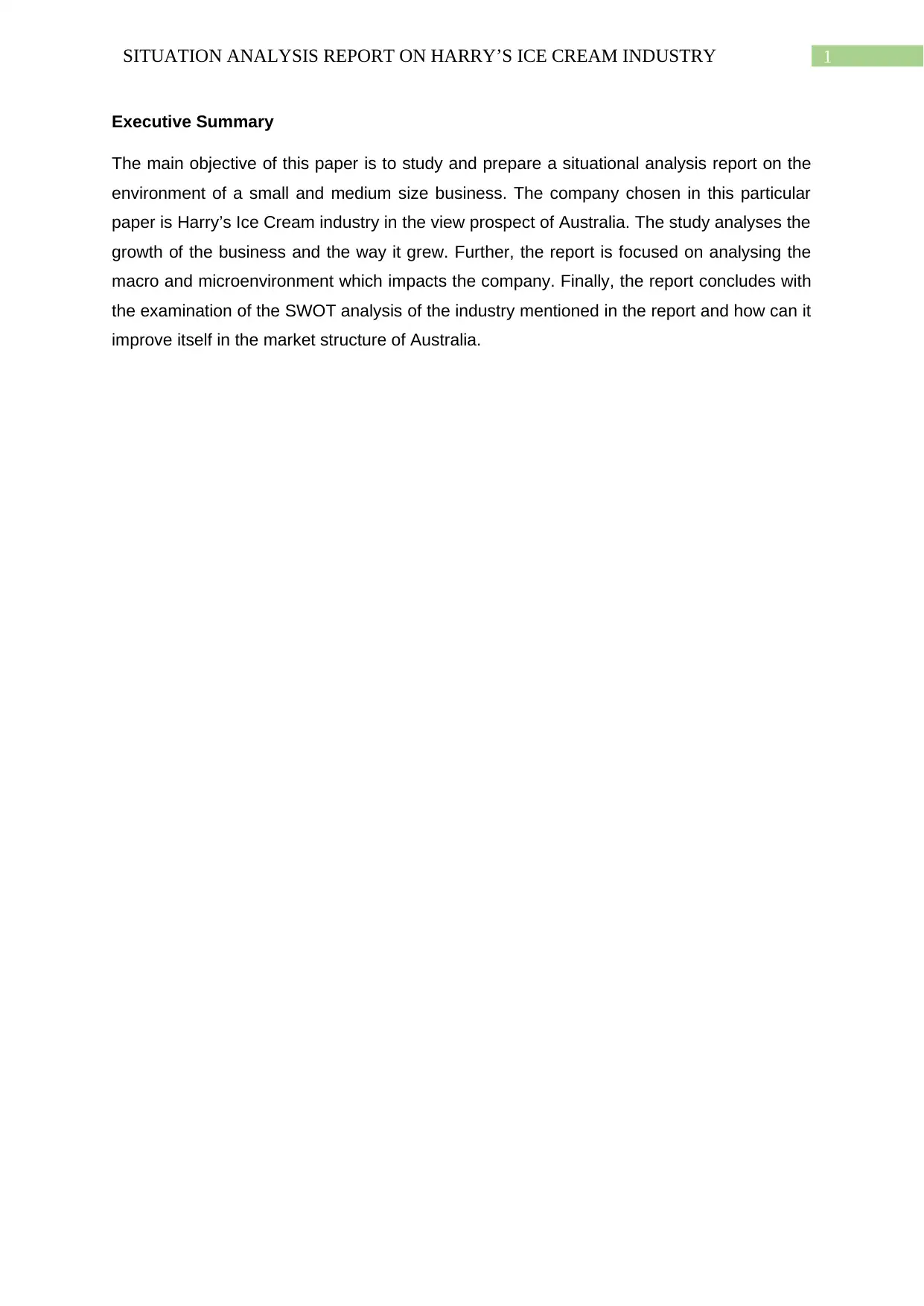
1SITUATION ANALYSIS REPORT ON HARRY’S ICE CREAM INDUSTRY
Executive Summary
The main objective of this paper is to study and prepare a situational analysis report on the
environment of a small and medium size business. The company chosen in this particular
paper is Harry’s Ice Cream industry in the view prospect of Australia. The study analyses the
growth of the business and the way it grew. Further, the report is focused on analysing the
macro and microenvironment which impacts the company. Finally, the report concludes with
the examination of the SWOT analysis of the industry mentioned in the report and how can it
improve itself in the market structure of Australia.
Executive Summary
The main objective of this paper is to study and prepare a situational analysis report on the
environment of a small and medium size business. The company chosen in this particular
paper is Harry’s Ice Cream industry in the view prospect of Australia. The study analyses the
growth of the business and the way it grew. Further, the report is focused on analysing the
macro and microenvironment which impacts the company. Finally, the report concludes with
the examination of the SWOT analysis of the industry mentioned in the report and how can it
improve itself in the market structure of Australia.
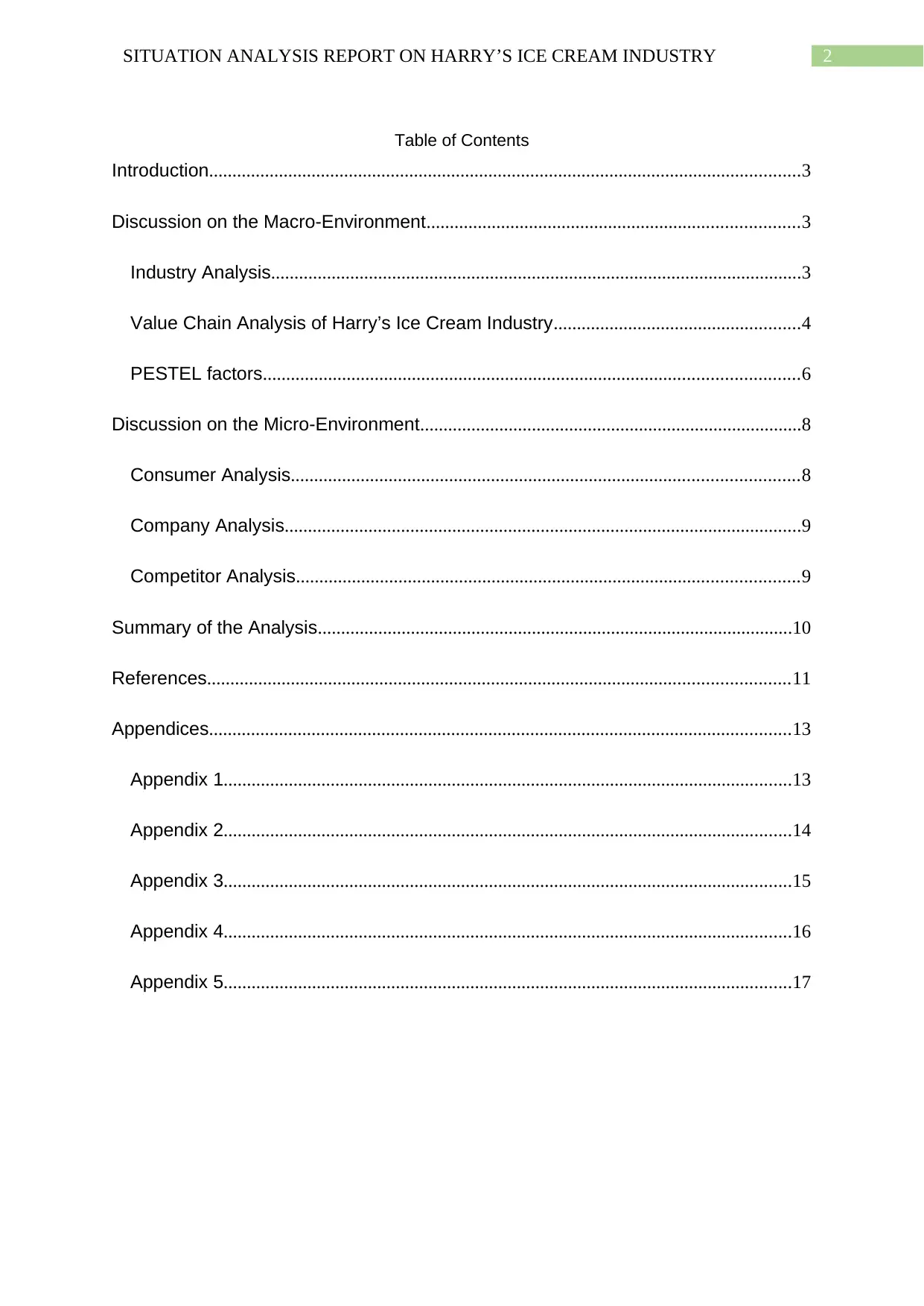
2SITUATION ANALYSIS REPORT ON HARRY’S ICE CREAM INDUSTRY
Table of Contents
Introduction...............................................................................................................................3
Discussion on the Macro-Environment................................................................................3
Industry Analysis..................................................................................................................3
Value Chain Analysis of Harry’s Ice Cream Industry.....................................................4
PESTEL factors...................................................................................................................6
Discussion on the Micro-Environment..................................................................................8
Consumer Analysis.............................................................................................................8
Company Analysis...............................................................................................................9
Competitor Analysis............................................................................................................9
Summary of the Analysis......................................................................................................10
References.............................................................................................................................11
Appendices.............................................................................................................................13
Appendix 1..........................................................................................................................13
Appendix 2..........................................................................................................................14
Appendix 3..........................................................................................................................15
Appendix 4..........................................................................................................................16
Appendix 5..........................................................................................................................17
Table of Contents
Introduction...............................................................................................................................3
Discussion on the Macro-Environment................................................................................3
Industry Analysis..................................................................................................................3
Value Chain Analysis of Harry’s Ice Cream Industry.....................................................4
PESTEL factors...................................................................................................................6
Discussion on the Micro-Environment..................................................................................8
Consumer Analysis.............................................................................................................8
Company Analysis...............................................................................................................9
Competitor Analysis............................................................................................................9
Summary of the Analysis......................................................................................................10
References.............................................................................................................................11
Appendices.............................................................................................................................13
Appendix 1..........................................................................................................................13
Appendix 2..........................................................................................................................14
Appendix 3..........................................................................................................................15
Appendix 4..........................................................................................................................16
Appendix 5..........................................................................................................................17
⊘ This is a preview!⊘
Do you want full access?
Subscribe today to unlock all pages.

Trusted by 1+ million students worldwide
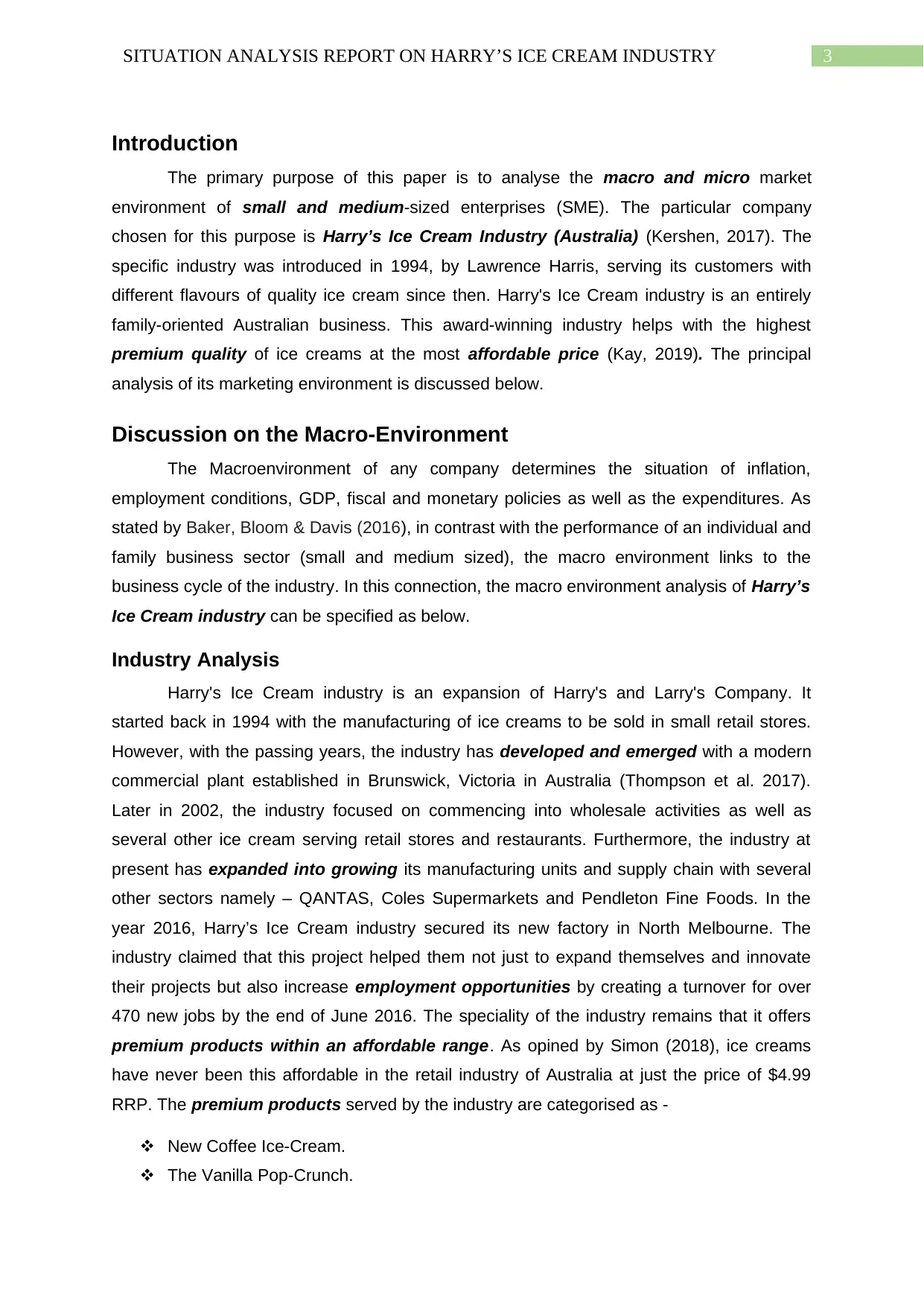
3SITUATION ANALYSIS REPORT ON HARRY’S ICE CREAM INDUSTRY
Introduction
The primary purpose of this paper is to analyse the macro and micro market
environment of small and medium-sized enterprises (SME). The particular company
chosen for this purpose is Harry’s Ice Cream Industry (Australia) (Kershen, 2017). The
specific industry was introduced in 1994, by Lawrence Harris, serving its customers with
different flavours of quality ice cream since then. Harry's Ice Cream industry is an entirely
family-oriented Australian business. This award-winning industry helps with the highest
premium quality of ice creams at the most affordable price (Kay, 2019). The principal
analysis of its marketing environment is discussed below.
Discussion on the Macro-Environment
The Macroenvironment of any company determines the situation of inflation,
employment conditions, GDP, fiscal and monetary policies as well as the expenditures. As
stated by Baker, Bloom & Davis (2016), in contrast with the performance of an individual and
family business sector (small and medium sized), the macro environment links to the
business cycle of the industry. In this connection, the macro environment analysis of Harry’s
Ice Cream industry can be specified as below.
Industry Analysis
Harry's Ice Cream industry is an expansion of Harry's and Larry's Company. It
started back in 1994 with the manufacturing of ice creams to be sold in small retail stores.
However, with the passing years, the industry has developed and emerged with a modern
commercial plant established in Brunswick, Victoria in Australia (Thompson et al. 2017).
Later in 2002, the industry focused on commencing into wholesale activities as well as
several other ice cream serving retail stores and restaurants. Furthermore, the industry at
present has expanded into growing its manufacturing units and supply chain with several
other sectors namely – QANTAS, Coles Supermarkets and Pendleton Fine Foods. In the
year 2016, Harry’s Ice Cream industry secured its new factory in North Melbourne. The
industry claimed that this project helped them not just to expand themselves and innovate
their projects but also increase employment opportunities by creating a turnover for over
470 new jobs by the end of June 2016. The speciality of the industry remains that it offers
premium products within an affordable range. As opined by Simon (2018), ice creams
have never been this affordable in the retail industry of Australia at just the price of $4.99
RRP. The premium products served by the industry are categorised as -
New Coffee Ice-Cream.
The Vanilla Pop-Crunch.
Introduction
The primary purpose of this paper is to analyse the macro and micro market
environment of small and medium-sized enterprises (SME). The particular company
chosen for this purpose is Harry’s Ice Cream Industry (Australia) (Kershen, 2017). The
specific industry was introduced in 1994, by Lawrence Harris, serving its customers with
different flavours of quality ice cream since then. Harry's Ice Cream industry is an entirely
family-oriented Australian business. This award-winning industry helps with the highest
premium quality of ice creams at the most affordable price (Kay, 2019). The principal
analysis of its marketing environment is discussed below.
Discussion on the Macro-Environment
The Macroenvironment of any company determines the situation of inflation,
employment conditions, GDP, fiscal and monetary policies as well as the expenditures. As
stated by Baker, Bloom & Davis (2016), in contrast with the performance of an individual and
family business sector (small and medium sized), the macro environment links to the
business cycle of the industry. In this connection, the macro environment analysis of Harry’s
Ice Cream industry can be specified as below.
Industry Analysis
Harry's Ice Cream industry is an expansion of Harry's and Larry's Company. It
started back in 1994 with the manufacturing of ice creams to be sold in small retail stores.
However, with the passing years, the industry has developed and emerged with a modern
commercial plant established in Brunswick, Victoria in Australia (Thompson et al. 2017).
Later in 2002, the industry focused on commencing into wholesale activities as well as
several other ice cream serving retail stores and restaurants. Furthermore, the industry at
present has expanded into growing its manufacturing units and supply chain with several
other sectors namely – QANTAS, Coles Supermarkets and Pendleton Fine Foods. In the
year 2016, Harry’s Ice Cream industry secured its new factory in North Melbourne. The
industry claimed that this project helped them not just to expand themselves and innovate
their projects but also increase employment opportunities by creating a turnover for over
470 new jobs by the end of June 2016. The speciality of the industry remains that it offers
premium products within an affordable range. As opined by Simon (2018), ice creams
have never been this affordable in the retail industry of Australia at just the price of $4.99
RRP. The premium products served by the industry are categorised as -
New Coffee Ice-Cream.
The Vanilla Pop-Crunch.
Paraphrase This Document
Need a fresh take? Get an instant paraphrase of this document with our AI Paraphraser
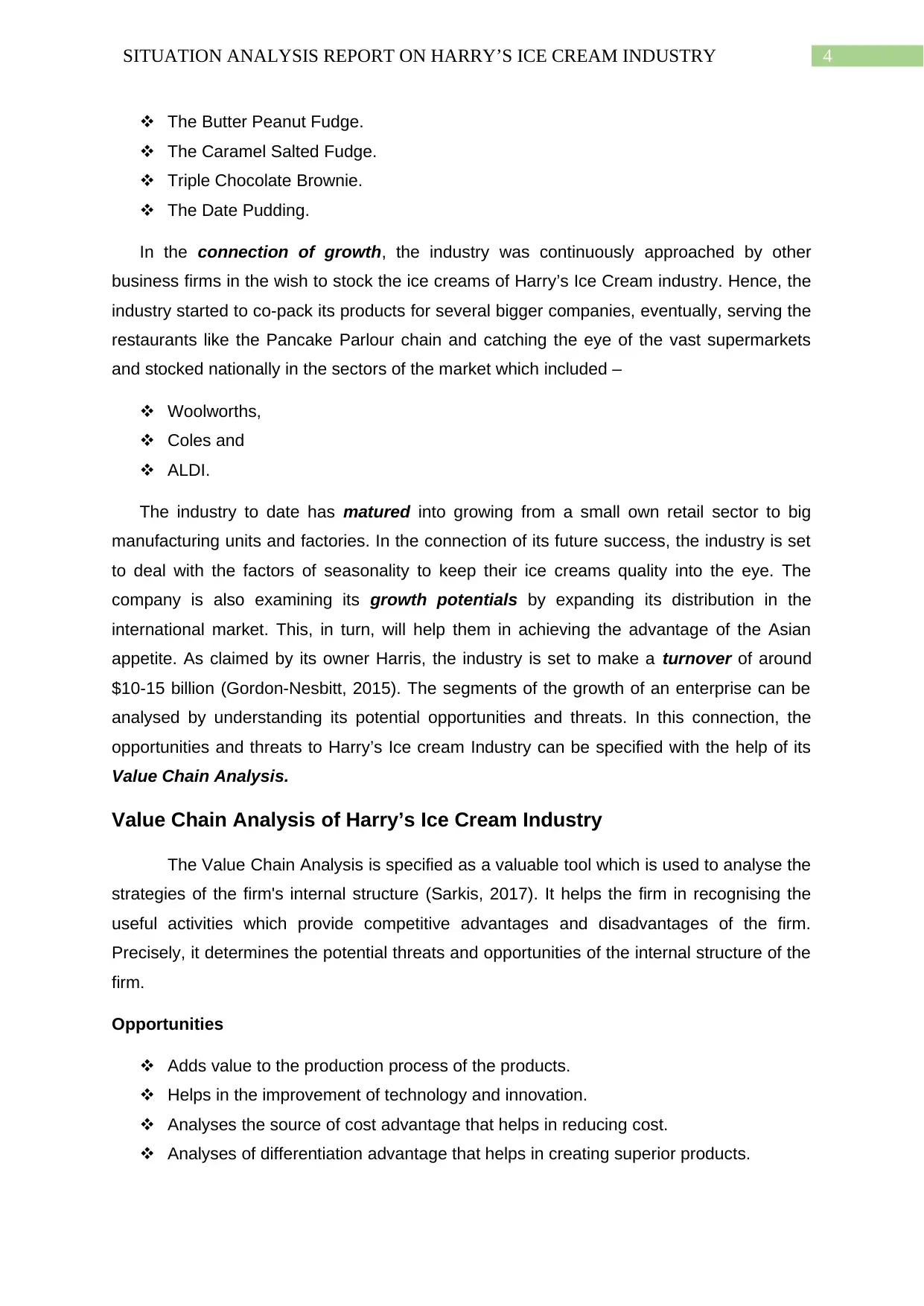
4SITUATION ANALYSIS REPORT ON HARRY’S ICE CREAM INDUSTRY
The Butter Peanut Fudge.
The Caramel Salted Fudge.
Triple Chocolate Brownie.
The Date Pudding.
In the connection of growth, the industry was continuously approached by other
business firms in the wish to stock the ice creams of Harry’s Ice Cream industry. Hence, the
industry started to co-pack its products for several bigger companies, eventually, serving the
restaurants like the Pancake Parlour chain and catching the eye of the vast supermarkets
and stocked nationally in the sectors of the market which included –
Woolworths,
Coles and
ALDI.
The industry to date has matured into growing from a small own retail sector to big
manufacturing units and factories. In the connection of its future success, the industry is set
to deal with the factors of seasonality to keep their ice creams quality into the eye. The
company is also examining its growth potentials by expanding its distribution in the
international market. This, in turn, will help them in achieving the advantage of the Asian
appetite. As claimed by its owner Harris, the industry is set to make a turnover of around
$10-15 billion (Gordon-Nesbitt, 2015). The segments of the growth of an enterprise can be
analysed by understanding its potential opportunities and threats. In this connection, the
opportunities and threats to Harry’s Ice cream Industry can be specified with the help of its
Value Chain Analysis.
Value Chain Analysis of Harry’s Ice Cream Industry
The Value Chain Analysis is specified as a valuable tool which is used to analyse the
strategies of the firm's internal structure (Sarkis, 2017). It helps the firm in recognising the
useful activities which provide competitive advantages and disadvantages of the firm.
Precisely, it determines the potential threats and opportunities of the internal structure of the
firm.
Opportunities
Adds value to the production process of the products.
Helps in the improvement of technology and innovation.
Analyses the source of cost advantage that helps in reducing cost.
Analyses of differentiation advantage that helps in creating superior products.
The Butter Peanut Fudge.
The Caramel Salted Fudge.
Triple Chocolate Brownie.
The Date Pudding.
In the connection of growth, the industry was continuously approached by other
business firms in the wish to stock the ice creams of Harry’s Ice Cream industry. Hence, the
industry started to co-pack its products for several bigger companies, eventually, serving the
restaurants like the Pancake Parlour chain and catching the eye of the vast supermarkets
and stocked nationally in the sectors of the market which included –
Woolworths,
Coles and
ALDI.
The industry to date has matured into growing from a small own retail sector to big
manufacturing units and factories. In the connection of its future success, the industry is set
to deal with the factors of seasonality to keep their ice creams quality into the eye. The
company is also examining its growth potentials by expanding its distribution in the
international market. This, in turn, will help them in achieving the advantage of the Asian
appetite. As claimed by its owner Harris, the industry is set to make a turnover of around
$10-15 billion (Gordon-Nesbitt, 2015). The segments of the growth of an enterprise can be
analysed by understanding its potential opportunities and threats. In this connection, the
opportunities and threats to Harry’s Ice cream Industry can be specified with the help of its
Value Chain Analysis.
Value Chain Analysis of Harry’s Ice Cream Industry
The Value Chain Analysis is specified as a valuable tool which is used to analyse the
strategies of the firm's internal structure (Sarkis, 2017). It helps the firm in recognising the
useful activities which provide competitive advantages and disadvantages of the firm.
Precisely, it determines the potential threats and opportunities of the internal structure of the
firm.
Opportunities
Adds value to the production process of the products.
Helps in the improvement of technology and innovation.
Analyses the source of cost advantage that helps in reducing cost.
Analyses of differentiation advantage that helps in creating superior products.
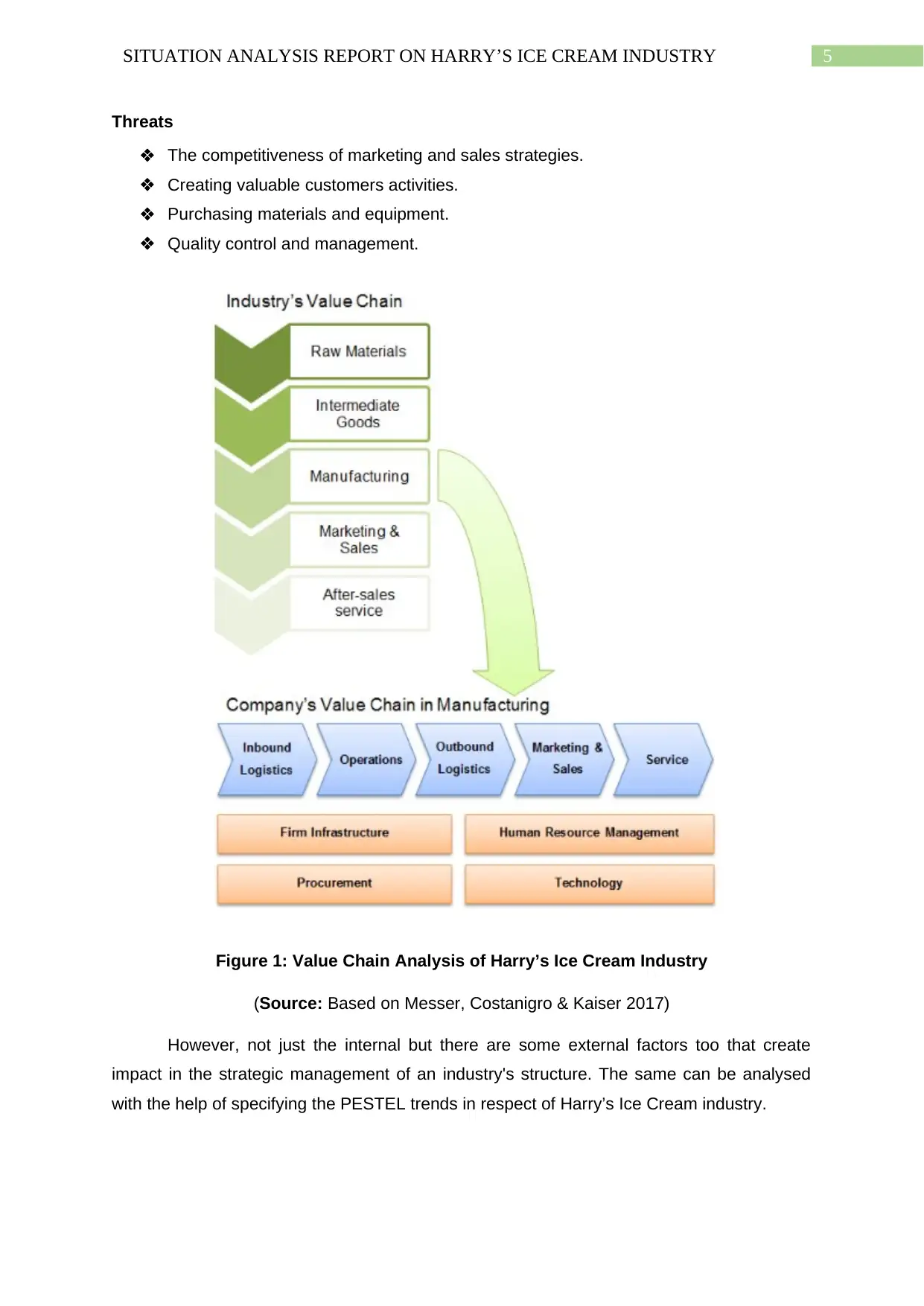
5SITUATION ANALYSIS REPORT ON HARRY’S ICE CREAM INDUSTRY
Threats
The competitiveness of marketing and sales strategies.
Creating valuable customers activities.
Purchasing materials and equipment.
Quality control and management.
Figure 1: Value Chain Analysis of Harry’s Ice Cream Industry
(Source: Based on Messer, Costanigro & Kaiser 2017)
However, not just the internal but there are some external factors too that create
impact in the strategic management of an industry's structure. The same can be analysed
with the help of specifying the PESTEL trends in respect of Harry’s Ice Cream industry.
Threats
The competitiveness of marketing and sales strategies.
Creating valuable customers activities.
Purchasing materials and equipment.
Quality control and management.
Figure 1: Value Chain Analysis of Harry’s Ice Cream Industry
(Source: Based on Messer, Costanigro & Kaiser 2017)
However, not just the internal but there are some external factors too that create
impact in the strategic management of an industry's structure. The same can be analysed
with the help of specifying the PESTEL trends in respect of Harry’s Ice Cream industry.
⊘ This is a preview!⊘
Do you want full access?
Subscribe today to unlock all pages.

Trusted by 1+ million students worldwide
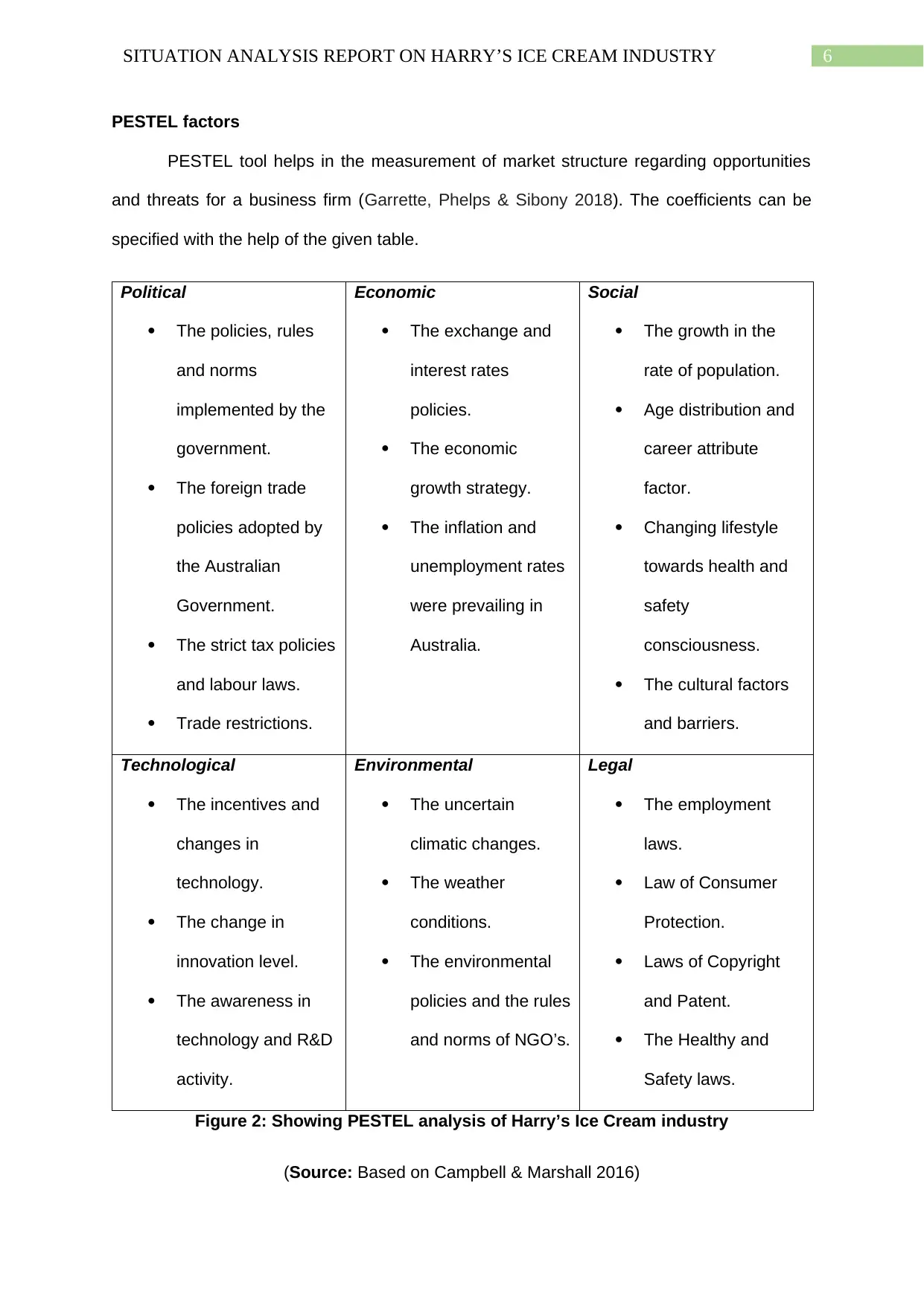
6SITUATION ANALYSIS REPORT ON HARRY’S ICE CREAM INDUSTRY
PESTEL factors
PESTEL tool helps in the measurement of market structure regarding opportunities
and threats for a business firm (Garrette, Phelps & Sibony 2018). The coefficients can be
specified with the help of the given table.
Political
The policies, rules
and norms
implemented by the
government.
The foreign trade
policies adopted by
the Australian
Government.
The strict tax policies
and labour laws.
Trade restrictions.
Economic
The exchange and
interest rates
policies.
The economic
growth strategy.
The inflation and
unemployment rates
were prevailing in
Australia.
Social
The growth in the
rate of population.
Age distribution and
career attribute
factor.
Changing lifestyle
towards health and
safety
consciousness.
The cultural factors
and barriers.
Technological
The incentives and
changes in
technology.
The change in
innovation level.
The awareness in
technology and R&D
activity.
Environmental
The uncertain
climatic changes.
The weather
conditions.
The environmental
policies and the rules
and norms of NGO’s.
Legal
The employment
laws.
Law of Consumer
Protection.
Laws of Copyright
and Patent.
The Healthy and
Safety laws.
Figure 2: Showing PESTEL analysis of Harry’s Ice Cream industry
(Source: Based on Campbell & Marshall 2016)
PESTEL factors
PESTEL tool helps in the measurement of market structure regarding opportunities
and threats for a business firm (Garrette, Phelps & Sibony 2018). The coefficients can be
specified with the help of the given table.
Political
The policies, rules
and norms
implemented by the
government.
The foreign trade
policies adopted by
the Australian
Government.
The strict tax policies
and labour laws.
Trade restrictions.
Economic
The exchange and
interest rates
policies.
The economic
growth strategy.
The inflation and
unemployment rates
were prevailing in
Australia.
Social
The growth in the
rate of population.
Age distribution and
career attribute
factor.
Changing lifestyle
towards health and
safety
consciousness.
The cultural factors
and barriers.
Technological
The incentives and
changes in
technology.
The change in
innovation level.
The awareness in
technology and R&D
activity.
Environmental
The uncertain
climatic changes.
The weather
conditions.
The environmental
policies and the rules
and norms of NGO’s.
Legal
The employment
laws.
Law of Consumer
Protection.
Laws of Copyright
and Patent.
The Healthy and
Safety laws.
Figure 2: Showing PESTEL analysis of Harry’s Ice Cream industry
(Source: Based on Campbell & Marshall 2016)
Paraphrase This Document
Need a fresh take? Get an instant paraphrase of this document with our AI Paraphraser
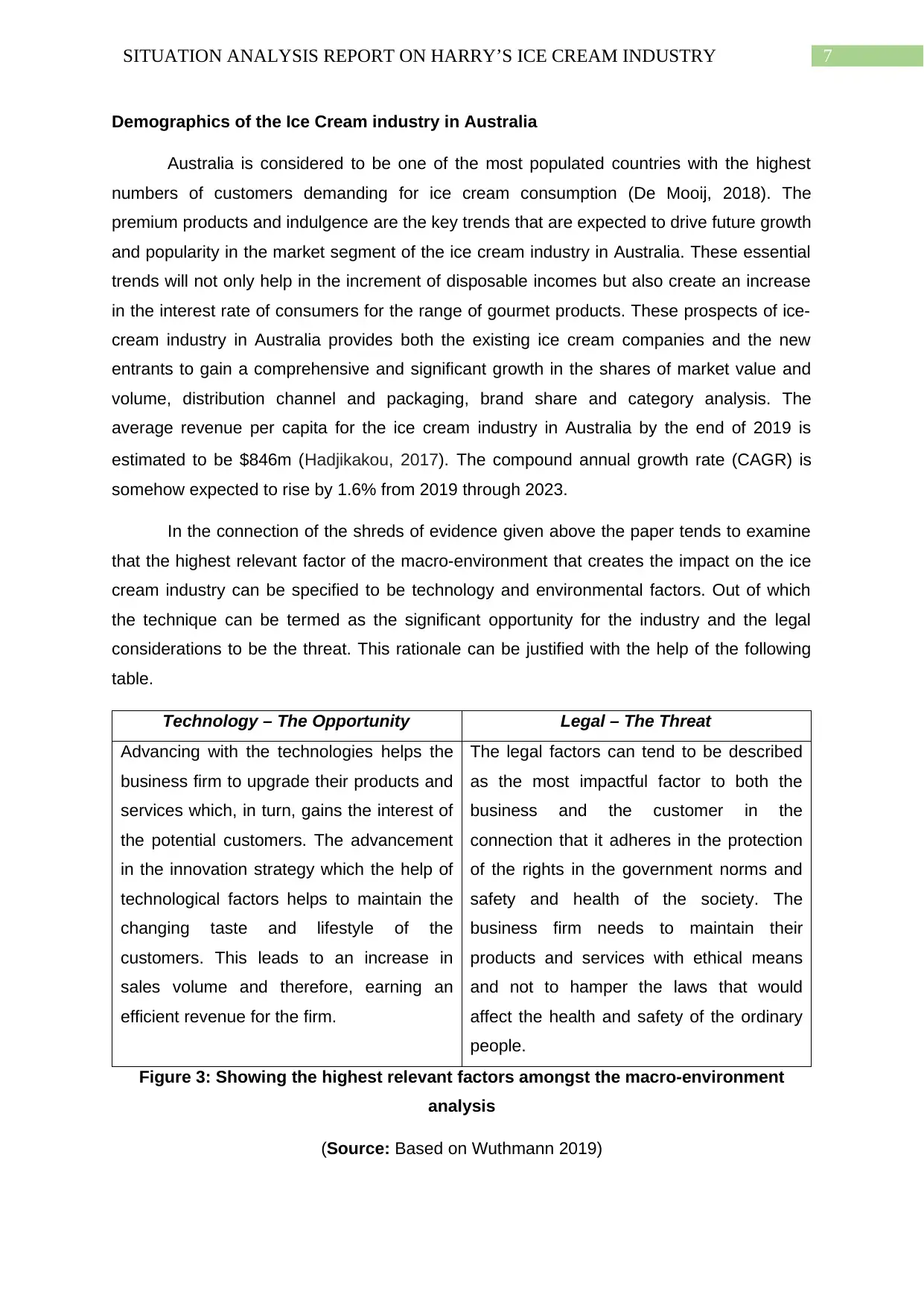
7SITUATION ANALYSIS REPORT ON HARRY’S ICE CREAM INDUSTRY
Demographics of the Ice Cream industry in Australia
Australia is considered to be one of the most populated countries with the highest
numbers of customers demanding for ice cream consumption (De Mooij, 2018). The
premium products and indulgence are the key trends that are expected to drive future growth
and popularity in the market segment of the ice cream industry in Australia. These essential
trends will not only help in the increment of disposable incomes but also create an increase
in the interest rate of consumers for the range of gourmet products. These prospects of ice-
cream industry in Australia provides both the existing ice cream companies and the new
entrants to gain a comprehensive and significant growth in the shares of market value and
volume, distribution channel and packaging, brand share and category analysis. The
average revenue per capita for the ice cream industry in Australia by the end of 2019 is
estimated to be $846m (Hadjikakou, 2017). The compound annual growth rate (CAGR) is
somehow expected to rise by 1.6% from 2019 through 2023.
In the connection of the shreds of evidence given above the paper tends to examine
that the highest relevant factor of the macro-environment that creates the impact on the ice
cream industry can be specified to be technology and environmental factors. Out of which
the technique can be termed as the significant opportunity for the industry and the legal
considerations to be the threat. This rationale can be justified with the help of the following
table.
Technology – The Opportunity Legal – The Threat
Advancing with the technologies helps the
business firm to upgrade their products and
services which, in turn, gains the interest of
the potential customers. The advancement
in the innovation strategy which the help of
technological factors helps to maintain the
changing taste and lifestyle of the
customers. This leads to an increase in
sales volume and therefore, earning an
efficient revenue for the firm.
The legal factors can tend to be described
as the most impactful factor to both the
business and the customer in the
connection that it adheres in the protection
of the rights in the government norms and
safety and health of the society. The
business firm needs to maintain their
products and services with ethical means
and not to hamper the laws that would
affect the health and safety of the ordinary
people.
Figure 3: Showing the highest relevant factors amongst the macro-environment
analysis
(Source: Based on Wuthmann 2019)
Demographics of the Ice Cream industry in Australia
Australia is considered to be one of the most populated countries with the highest
numbers of customers demanding for ice cream consumption (De Mooij, 2018). The
premium products and indulgence are the key trends that are expected to drive future growth
and popularity in the market segment of the ice cream industry in Australia. These essential
trends will not only help in the increment of disposable incomes but also create an increase
in the interest rate of consumers for the range of gourmet products. These prospects of ice-
cream industry in Australia provides both the existing ice cream companies and the new
entrants to gain a comprehensive and significant growth in the shares of market value and
volume, distribution channel and packaging, brand share and category analysis. The
average revenue per capita for the ice cream industry in Australia by the end of 2019 is
estimated to be $846m (Hadjikakou, 2017). The compound annual growth rate (CAGR) is
somehow expected to rise by 1.6% from 2019 through 2023.
In the connection of the shreds of evidence given above the paper tends to examine
that the highest relevant factor of the macro-environment that creates the impact on the ice
cream industry can be specified to be technology and environmental factors. Out of which
the technique can be termed as the significant opportunity for the industry and the legal
considerations to be the threat. This rationale can be justified with the help of the following
table.
Technology – The Opportunity Legal – The Threat
Advancing with the technologies helps the
business firm to upgrade their products and
services which, in turn, gains the interest of
the potential customers. The advancement
in the innovation strategy which the help of
technological factors helps to maintain the
changing taste and lifestyle of the
customers. This leads to an increase in
sales volume and therefore, earning an
efficient revenue for the firm.
The legal factors can tend to be described
as the most impactful factor to both the
business and the customer in the
connection that it adheres in the protection
of the rights in the government norms and
safety and health of the society. The
business firm needs to maintain their
products and services with ethical means
and not to hamper the laws that would
affect the health and safety of the ordinary
people.
Figure 3: Showing the highest relevant factors amongst the macro-environment
analysis
(Source: Based on Wuthmann 2019)
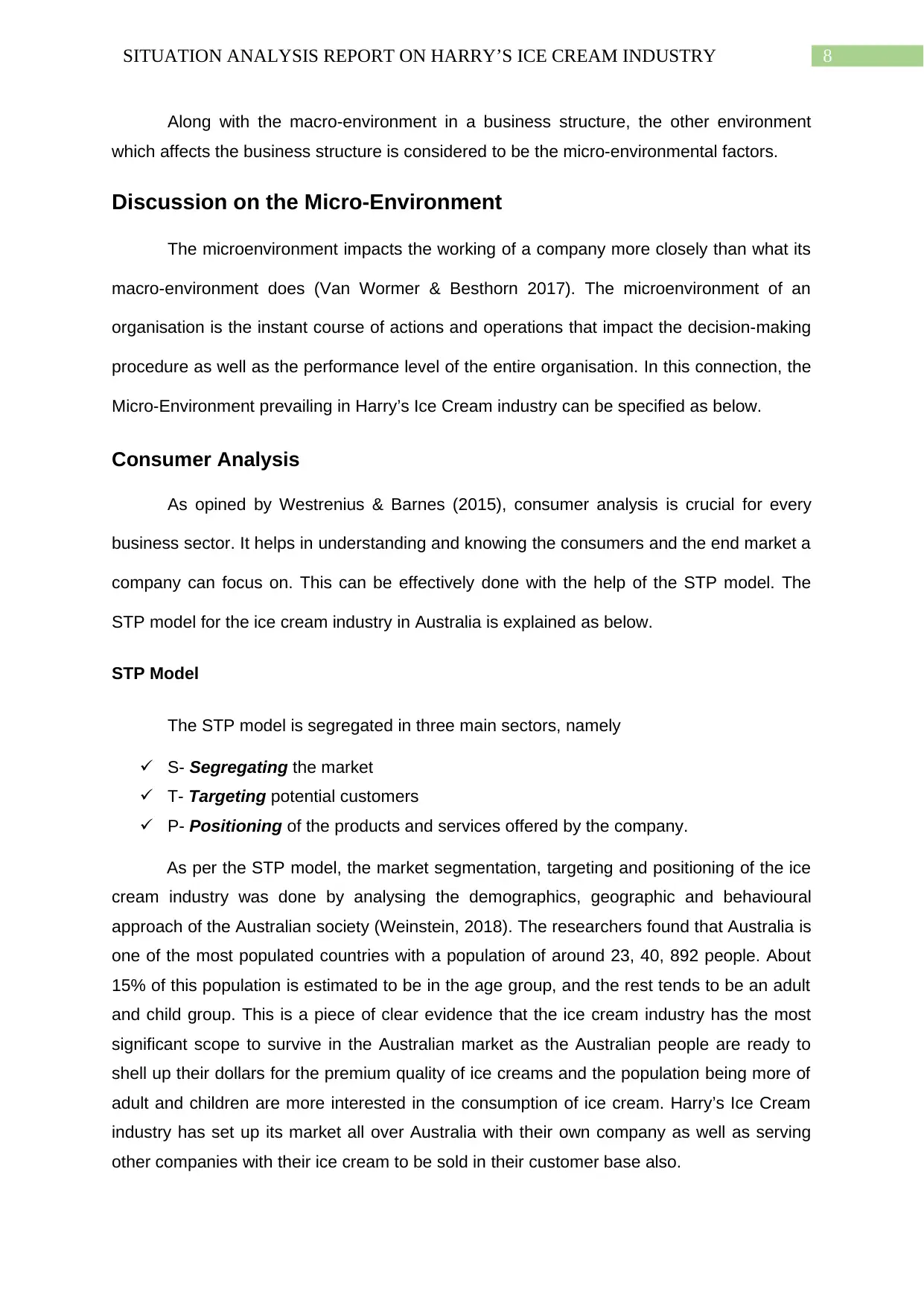
8SITUATION ANALYSIS REPORT ON HARRY’S ICE CREAM INDUSTRY
Along with the macro-environment in a business structure, the other environment
which affects the business structure is considered to be the micro-environmental factors.
Discussion on the Micro-Environment
The microenvironment impacts the working of a company more closely than what its
macro-environment does (Van Wormer & Besthorn 2017). The microenvironment of an
organisation is the instant course of actions and operations that impact the decision-making
procedure as well as the performance level of the entire organisation. In this connection, the
Micro-Environment prevailing in Harry’s Ice Cream industry can be specified as below.
Consumer Analysis
As opined by Westrenius & Barnes (2015), consumer analysis is crucial for every
business sector. It helps in understanding and knowing the consumers and the end market a
company can focus on. This can be effectively done with the help of the STP model. The
STP model for the ice cream industry in Australia is explained as below.
STP Model
The STP model is segregated in three main sectors, namely
S- Segregating the market
T- Targeting potential customers
P- Positioning of the products and services offered by the company.
As per the STP model, the market segmentation, targeting and positioning of the ice
cream industry was done by analysing the demographics, geographic and behavioural
approach of the Australian society (Weinstein, 2018). The researchers found that Australia is
one of the most populated countries with a population of around 23, 40, 892 people. About
15% of this population is estimated to be in the age group, and the rest tends to be an adult
and child group. This is a piece of clear evidence that the ice cream industry has the most
significant scope to survive in the Australian market as the Australian people are ready to
shell up their dollars for the premium quality of ice creams and the population being more of
adult and children are more interested in the consumption of ice cream. Harry’s Ice Cream
industry has set up its market all over Australia with their own company as well as serving
other companies with their ice cream to be sold in their customer base also.
Along with the macro-environment in a business structure, the other environment
which affects the business structure is considered to be the micro-environmental factors.
Discussion on the Micro-Environment
The microenvironment impacts the working of a company more closely than what its
macro-environment does (Van Wormer & Besthorn 2017). The microenvironment of an
organisation is the instant course of actions and operations that impact the decision-making
procedure as well as the performance level of the entire organisation. In this connection, the
Micro-Environment prevailing in Harry’s Ice Cream industry can be specified as below.
Consumer Analysis
As opined by Westrenius & Barnes (2015), consumer analysis is crucial for every
business sector. It helps in understanding and knowing the consumers and the end market a
company can focus on. This can be effectively done with the help of the STP model. The
STP model for the ice cream industry in Australia is explained as below.
STP Model
The STP model is segregated in three main sectors, namely
S- Segregating the market
T- Targeting potential customers
P- Positioning of the products and services offered by the company.
As per the STP model, the market segmentation, targeting and positioning of the ice
cream industry was done by analysing the demographics, geographic and behavioural
approach of the Australian society (Weinstein, 2018). The researchers found that Australia is
one of the most populated countries with a population of around 23, 40, 892 people. About
15% of this population is estimated to be in the age group, and the rest tends to be an adult
and child group. This is a piece of clear evidence that the ice cream industry has the most
significant scope to survive in the Australian market as the Australian people are ready to
shell up their dollars for the premium quality of ice creams and the population being more of
adult and children are more interested in the consumption of ice cream. Harry’s Ice Cream
industry has set up its market all over Australia with their own company as well as serving
other companies with their ice cream to be sold in their customer base also.
⊘ This is a preview!⊘
Do you want full access?
Subscribe today to unlock all pages.

Trusted by 1+ million students worldwide
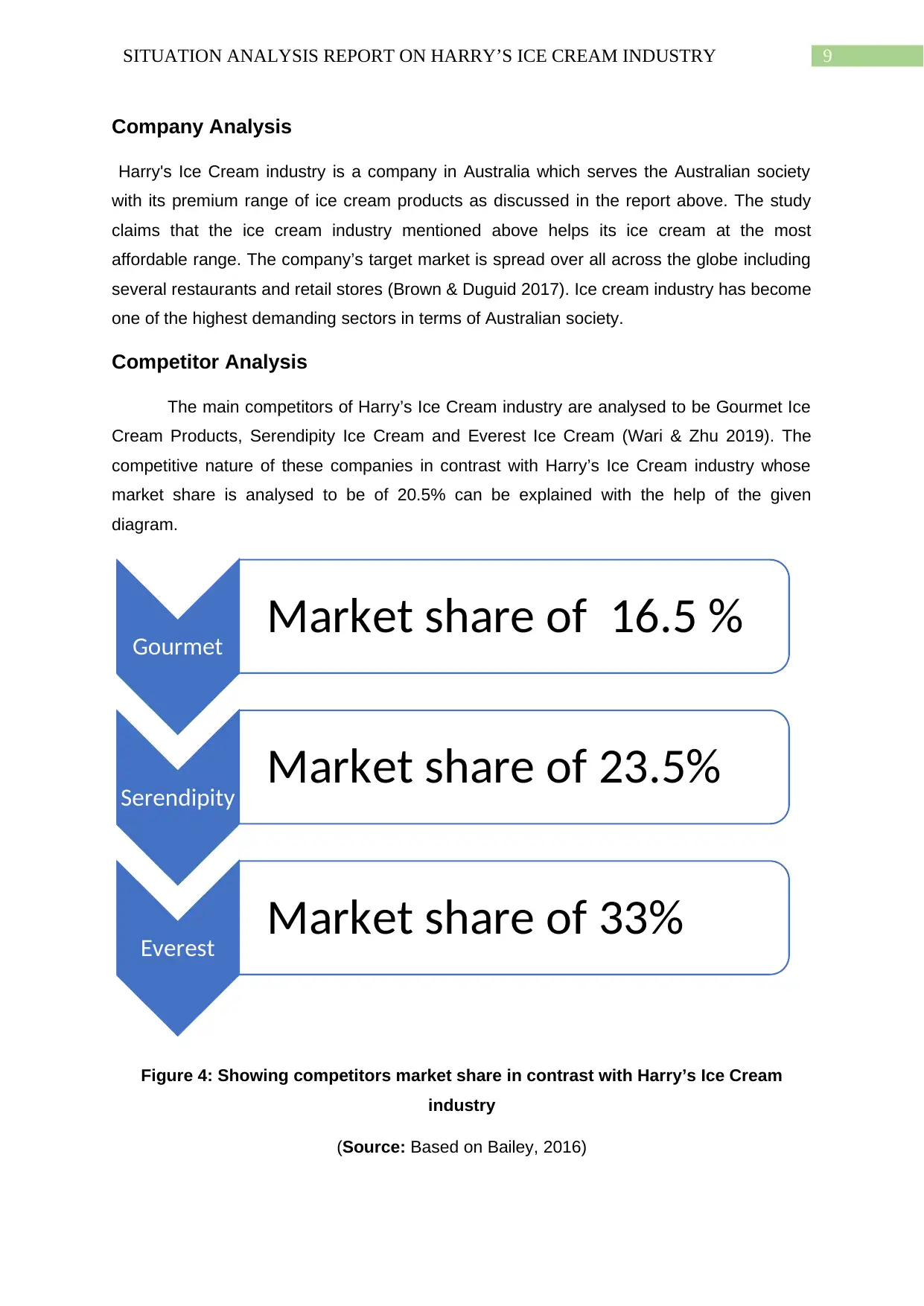
9SITUATION ANALYSIS REPORT ON HARRY’S ICE CREAM INDUSTRY
Company Analysis
Harry's Ice Cream industry is a company in Australia which serves the Australian society
with its premium range of ice cream products as discussed in the report above. The study
claims that the ice cream industry mentioned above helps its ice cream at the most
affordable range. The company’s target market is spread over all across the globe including
several restaurants and retail stores (Brown & Duguid 2017). Ice cream industry has become
one of the highest demanding sectors in terms of Australian society.
Competitor Analysis
The main competitors of Harry’s Ice Cream industry are analysed to be Gourmet Ice
Cream Products, Serendipity Ice Cream and Everest Ice Cream (Wari & Zhu 2019). The
competitive nature of these companies in contrast with Harry’s Ice Cream industry whose
market share is analysed to be of 20.5% can be explained with the help of the given
diagram.
Figure 4: Showing competitors market share in contrast with Harry’s Ice Cream
industry
(Source: Based on Bailey, 2016)
Gourmet Market share of 16.5 %
Serendipity Market share of 23.5%
Everest Market share of 33%
Company Analysis
Harry's Ice Cream industry is a company in Australia which serves the Australian society
with its premium range of ice cream products as discussed in the report above. The study
claims that the ice cream industry mentioned above helps its ice cream at the most
affordable range. The company’s target market is spread over all across the globe including
several restaurants and retail stores (Brown & Duguid 2017). Ice cream industry has become
one of the highest demanding sectors in terms of Australian society.
Competitor Analysis
The main competitors of Harry’s Ice Cream industry are analysed to be Gourmet Ice
Cream Products, Serendipity Ice Cream and Everest Ice Cream (Wari & Zhu 2019). The
competitive nature of these companies in contrast with Harry’s Ice Cream industry whose
market share is analysed to be of 20.5% can be explained with the help of the given
diagram.
Figure 4: Showing competitors market share in contrast with Harry’s Ice Cream
industry
(Source: Based on Bailey, 2016)
Gourmet Market share of 16.5 %
Serendipity Market share of 23.5%
Everest Market share of 33%
Paraphrase This Document
Need a fresh take? Get an instant paraphrase of this document with our AI Paraphraser
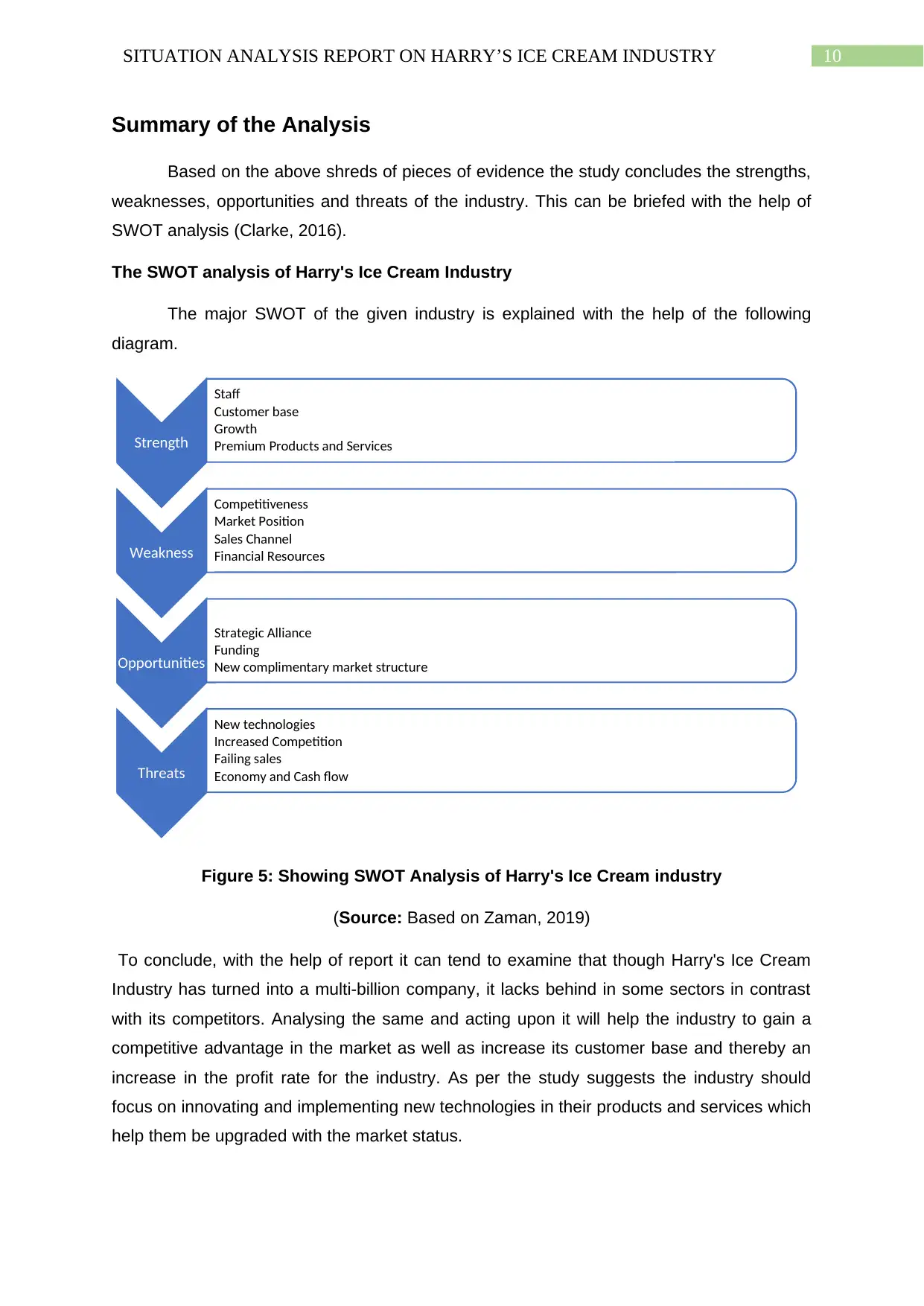
10SITUATION ANALYSIS REPORT ON HARRY’S ICE CREAM INDUSTRY
Summary of the Analysis
Based on the above shreds of pieces of evidence the study concludes the strengths,
weaknesses, opportunities and threats of the industry. This can be briefed with the help of
SWOT analysis (Clarke, 2016).
The SWOT analysis of Harry's Ice Cream Industry
The major SWOT of the given industry is explained with the help of the following
diagram.
Figure 5: Showing SWOT Analysis of Harry's Ice Cream industry
(Source: Based on Zaman, 2019)
To conclude, with the help of report it can tend to examine that though Harry's Ice Cream
Industry has turned into a multi-billion company, it lacks behind in some sectors in contrast
with its competitors. Analysing the same and acting upon it will help the industry to gain a
competitive advantage in the market as well as increase its customer base and thereby an
increase in the profit rate for the industry. As per the study suggests the industry should
focus on innovating and implementing new technologies in their products and services which
help them be upgraded with the market status.
Strength
Staff
Customer base
Growth
Premium Products and Services
Weakness
Competitiveness
Market Position
Sales Channel
Financial Resources
Opportunities
Strategic Alliance
Funding
New complimentary market structure
Threats
New technologies
Increased Competition
Failing sales
Economy and Cash flow
Summary of the Analysis
Based on the above shreds of pieces of evidence the study concludes the strengths,
weaknesses, opportunities and threats of the industry. This can be briefed with the help of
SWOT analysis (Clarke, 2016).
The SWOT analysis of Harry's Ice Cream Industry
The major SWOT of the given industry is explained with the help of the following
diagram.
Figure 5: Showing SWOT Analysis of Harry's Ice Cream industry
(Source: Based on Zaman, 2019)
To conclude, with the help of report it can tend to examine that though Harry's Ice Cream
Industry has turned into a multi-billion company, it lacks behind in some sectors in contrast
with its competitors. Analysing the same and acting upon it will help the industry to gain a
competitive advantage in the market as well as increase its customer base and thereby an
increase in the profit rate for the industry. As per the study suggests the industry should
focus on innovating and implementing new technologies in their products and services which
help them be upgraded with the market status.
Strength
Staff
Customer base
Growth
Premium Products and Services
Weakness
Competitiveness
Market Position
Sales Channel
Financial Resources
Opportunities
Strategic Alliance
Funding
New complimentary market structure
Threats
New technologies
Increased Competition
Failing sales
Economy and Cash flow
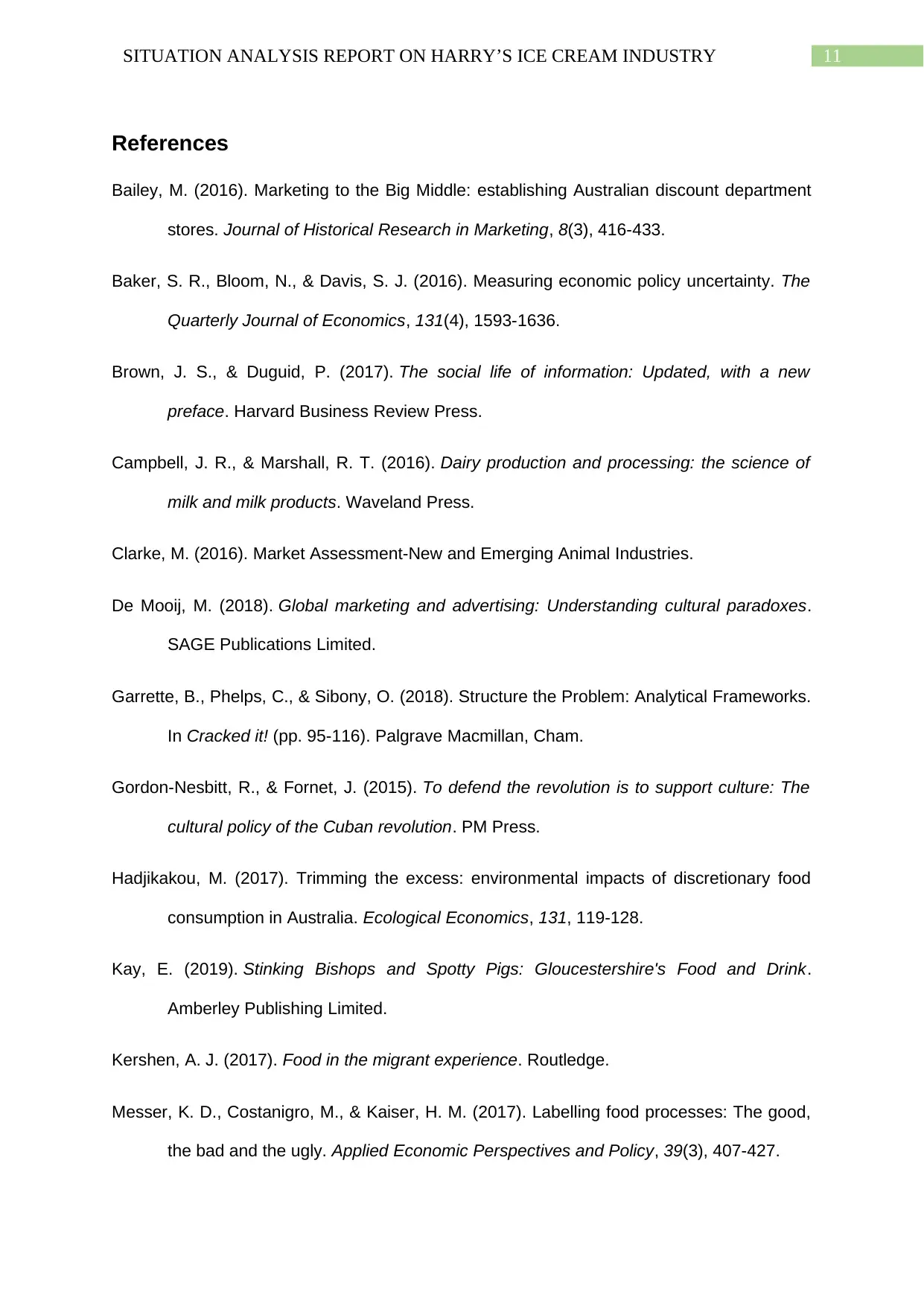
11SITUATION ANALYSIS REPORT ON HARRY’S ICE CREAM INDUSTRY
References
Bailey, M. (2016). Marketing to the Big Middle: establishing Australian discount department
stores. Journal of Historical Research in Marketing, 8(3), 416-433.
Baker, S. R., Bloom, N., & Davis, S. J. (2016). Measuring economic policy uncertainty. The
Quarterly Journal of Economics, 131(4), 1593-1636.
Brown, J. S., & Duguid, P. (2017). The social life of information: Updated, with a new
preface. Harvard Business Review Press.
Campbell, J. R., & Marshall, R. T. (2016). Dairy production and processing: the science of
milk and milk products. Waveland Press.
Clarke, M. (2016). Market Assessment-New and Emerging Animal Industries.
De Mooij, M. (2018). Global marketing and advertising: Understanding cultural paradoxes.
SAGE Publications Limited.
Garrette, B., Phelps, C., & Sibony, O. (2018). Structure the Problem: Analytical Frameworks.
In Cracked it! (pp. 95-116). Palgrave Macmillan, Cham.
Gordon-Nesbitt, R., & Fornet, J. (2015). To defend the revolution is to support culture: The
cultural policy of the Cuban revolution. PM Press.
Hadjikakou, M. (2017). Trimming the excess: environmental impacts of discretionary food
consumption in Australia. Ecological Economics, 131, 119-128.
Kay, E. (2019). Stinking Bishops and Spotty Pigs: Gloucestershire's Food and Drink.
Amberley Publishing Limited.
Kershen, A. J. (2017). Food in the migrant experience. Routledge.
Messer, K. D., Costanigro, M., & Kaiser, H. M. (2017). Labelling food processes: The good,
the bad and the ugly. Applied Economic Perspectives and Policy, 39(3), 407-427.
References
Bailey, M. (2016). Marketing to the Big Middle: establishing Australian discount department
stores. Journal of Historical Research in Marketing, 8(3), 416-433.
Baker, S. R., Bloom, N., & Davis, S. J. (2016). Measuring economic policy uncertainty. The
Quarterly Journal of Economics, 131(4), 1593-1636.
Brown, J. S., & Duguid, P. (2017). The social life of information: Updated, with a new
preface. Harvard Business Review Press.
Campbell, J. R., & Marshall, R. T. (2016). Dairy production and processing: the science of
milk and milk products. Waveland Press.
Clarke, M. (2016). Market Assessment-New and Emerging Animal Industries.
De Mooij, M. (2018). Global marketing and advertising: Understanding cultural paradoxes.
SAGE Publications Limited.
Garrette, B., Phelps, C., & Sibony, O. (2018). Structure the Problem: Analytical Frameworks.
In Cracked it! (pp. 95-116). Palgrave Macmillan, Cham.
Gordon-Nesbitt, R., & Fornet, J. (2015). To defend the revolution is to support culture: The
cultural policy of the Cuban revolution. PM Press.
Hadjikakou, M. (2017). Trimming the excess: environmental impacts of discretionary food
consumption in Australia. Ecological Economics, 131, 119-128.
Kay, E. (2019). Stinking Bishops and Spotty Pigs: Gloucestershire's Food and Drink.
Amberley Publishing Limited.
Kershen, A. J. (2017). Food in the migrant experience. Routledge.
Messer, K. D., Costanigro, M., & Kaiser, H. M. (2017). Labelling food processes: The good,
the bad and the ugly. Applied Economic Perspectives and Policy, 39(3), 407-427.
⊘ This is a preview!⊘
Do you want full access?
Subscribe today to unlock all pages.

Trusted by 1+ million students worldwide
1 out of 18
Related Documents
Your All-in-One AI-Powered Toolkit for Academic Success.
+13062052269
info@desklib.com
Available 24*7 on WhatsApp / Email
![[object Object]](/_next/static/media/star-bottom.7253800d.svg)
Unlock your academic potential
Copyright © 2020–2025 A2Z Services. All Rights Reserved. Developed and managed by ZUCOL.




